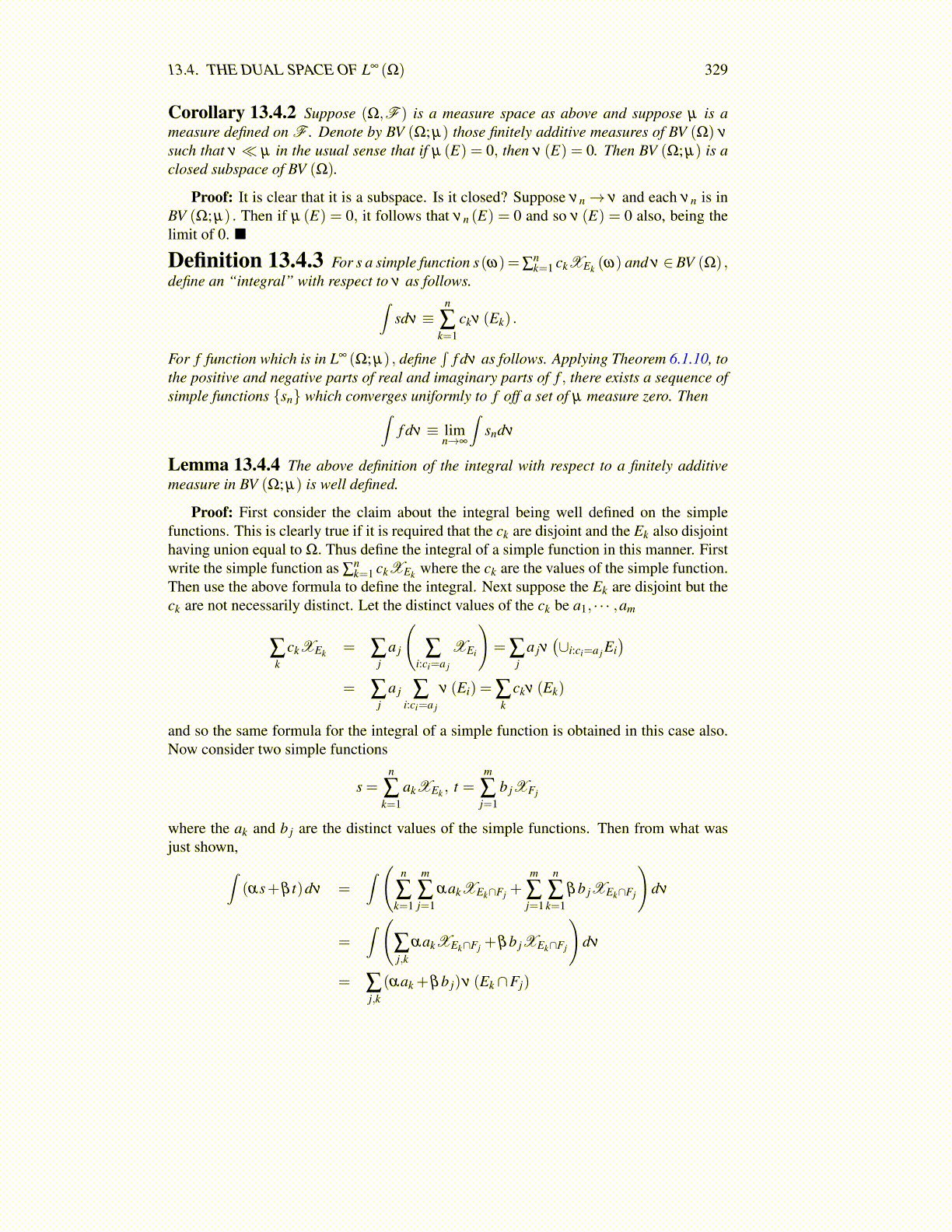
13.4. THE DUAL SPACE OF L∞ (Ω) 329
Corollary 13.4.2 Suppose (Ω,F ) is a measure space as above and suppose µ is ameasure defined on F . Denote by BV (Ω; µ) those finitely additive measures of BV (Ω) ν
such that ν ≪ µ in the usual sense that if µ (E) = 0, then ν (E) = 0. Then BV (Ω; µ) is aclosed subspace of BV (Ω).
Proof: It is clear that it is a subspace. Is it closed? Suppose νn→ ν and each νn is inBV (Ω; µ) . Then if µ (E) = 0, it follows that νn (E) = 0 and so ν (E) = 0 also, being thelimit of 0. ■
Definition 13.4.3 For s a simple function s(ω)=∑nk=1 ckXEk (ω) and ν ∈BV (Ω) ,
define an “integral” with respect to ν as follows.∫sdν ≡
n
∑k=1
ckν (Ek) .
For f function which is in L∞ (Ω; µ) , define∫
f dν as follows. Applying Theorem 6.1.10, tothe positive and negative parts of real and imaginary parts of f , there exists a sequence ofsimple functions {sn} which converges uniformly to f off a set of µ measure zero. Then∫
f dν ≡ limn→∞
∫sndν
Lemma 13.4.4 The above definition of the integral with respect to a finitely additivemeasure in BV (Ω; µ) is well defined.
Proof: First consider the claim about the integral being well defined on the simplefunctions. This is clearly true if it is required that the ck are disjoint and the Ek also disjointhaving union equal to Ω. Thus define the integral of a simple function in this manner. Firstwrite the simple function as ∑
nk=1 ckXEk where the ck are the values of the simple function.
Then use the above formula to define the integral. Next suppose the Ek are disjoint but theck are not necessarily distinct. Let the distinct values of the ck be a1, · · · ,am
∑k
ckXEk = ∑j
a j
(∑
i:ci=a j
XEi
)= ∑
ja jν
(∪i:ci=a j Ei
)= ∑
ja j ∑
i:ci=a j
ν (Ei) = ∑k
ckν (Ek)
and so the same formula for the integral of a simple function is obtained in this case also.Now consider two simple functions
s =n
∑k=1
akXEk , t =m
∑j=1
b jXFj
where the ak and b j are the distinct values of the simple functions. Then from what wasjust shown,∫
(αs+β t)dν =∫ ( n
∑k=1
m
∑j=1
αakXEk∩Fj +m
∑j=1
n
∑k=1
βb jXEk∩Fj
)dν
=∫ (
∑j,k
αakXEk∩Fj +βb jXEk∩Fj
)dν
= ∑j,k(αak +βb j)ν (Ek ∩Fj)